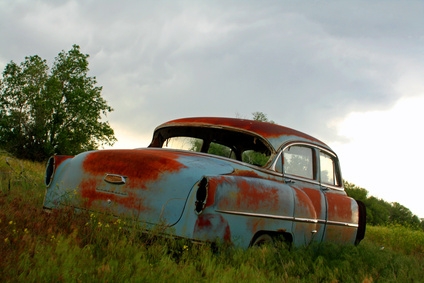
UV clear-coat delamination is the process by which the clear coat begins to separate and peel away from the base coat. This begins with air bubbles forming under the surface of the clear coat as the bond between the clear coat and base coat weakens. If left untreated, these bubbles will become pinholes, expand in size and gradually lead to the clear coat peeling away. As the clear coat provides protection from moisture and the sun, this process may lead to the formation of rust.
An insufficient amount of clear coat will provide little protection from the elements, eventually leading to relatively rapid and even ultraviolet clear-coat delamination. Although too much buffing may help strip away the clear coat, more likely scenarios stem from manufacturer limits on the amount of clear coat applied and poor paint jobs.
Overexposure to the sun can accelerate the process by which the bond between the clear coat and base coat naturally degrades. Although this will only somewhat decrease the lifespan of your clear coat, it is best to keep your vehicle in a shaded or enclosed area.
The clear coat and base coat expand and contract with fluctuations in temperature and each may do so at a different rate. This can severely weaken the bond between the two, eventually leading to UV clear-coat delamination. As with protection from overexposure to the sun, it is best to keep your vehicle in an enclosed, ideally temperature-controlled area.
Again, this may be the fault of either the manufacturer or an auto body shop, though it is more likely to occur after repainting. Without sufficient time for the base coat or clear-coat layers to dry, the clear coat's protective abilities will be severely compromised. This can arise either from exposure to the elements before the clear coat has dried or from the clear coat blending with the base coat, thus resulting in a spotty and impure clear coat.
Over time, UV rays and light are either absorbed by or penetrate the clear coat. This leads to photo oxidation, a process that produces chemical changes in the clear coat. These changes reduce the molecular weight of the chemicals in the clear coat, making it more brittle and less scratch-resistant. With time, even the slightest abrasion to the surface of the clear coat will result in minute cracks, eventually leading to pinholes and peeling.
There is great variation in the extent to which clear coats provide protection from water and moisture. Moisture collecting under the clear coat will both weaken the bond between clear coat and base coat and lead to the production of air bubbles between the two. Again, keeping your vehicle in an enclosed area is the best way to avoid the collection of water and moisture on its surface.
Although an unlikely scenario, an inexperienced painter may have used different substrates, e.g., lacquer, acrylic, for the different coats. This mixing of substrates may be performed safely with the use of an intermediary layer, but without such a barrier it is likely that one layer may accelerate the breakdown of another.